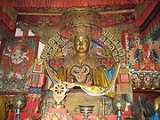
Buddhism in Mongolia
Encyclopedia
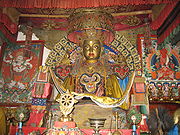
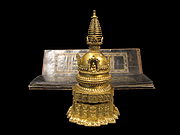
Tibetan Buddhism
Tibetan Buddhism is the body of Buddhist religious doctrine and institutions characteristic of Tibet and certain regions of the Himalayas, including northern Nepal, Bhutan, and India . It is the state religion of Bhutan...
of the Gelugpa school. Traditionally, Mongols
Mongols
Mongols ) are a Central-East Asian ethnic group that lives mainly in the countries of Mongolia, China, and Russia. In China, ethnic Mongols can be found mainly in the central north region of China such as Inner Mongolia...
worshiped heaven
Heaven
Heaven, the Heavens or Seven Heavens, is a common religious cosmological or metaphysical term for the physical or transcendent place from which heavenly beings originate, are enthroned or inhabit...
(the "eternal blue sky") and their ancestors, and they followed ancient northern Asian practices of shamanism
Shamanism
Shamanism is an anthropological term referencing a range of beliefs and practices regarding communication with the spiritual world. To quote Eliade: "A first definition of this complex phenomenon, and perhaps the least hazardous, will be: shamanism = technique of ecstasy." Shamanism encompasses the...
, in which human intermediaries went into trance
Trance
Trance denotes a variety of processes, ecstasy, techniques, modalities and states of mind, awareness and consciousness. Trance states may occur involuntarily and unbidden.The term trance may be associated with meditation, magic, flow, and prayer...
and spoke to and for some of the numberless infinities of spirits responsible for human luck or misfortune. Although the emperors of the Yuan Dynasty
Yuan Dynasty
The Yuan Dynasty , or Great Yuan Empire was a ruling dynasty founded by the Mongol leader Kublai Khan, who ruled most of present-day China, all of modern Mongolia and its surrounding areas, lasting officially from 1271 to 1368. It is considered both as a division of the Mongol Empire and as an...
in the 14th and 15th century had already converted to Tibetan buddhism, the Mongols returned to their old shamanist ways after the collapse of their empire. In 1578 Altan Khan
Altan Khan
Altan Khan , whose given name was Anda , was the ruler of the Tümet Mongols and de facto ruler of the Right Wing, or western tribes, of the Mongols...
, a Mongol military leader with ambitions to unite the Mongols and to emulate the career of Chinggis, invited the head of the rising Yellow Sect
Gelug
The Gelug or Gelug-pa , also known as the Yellow Hat sect, is a school of Buddhism founded by Je Tsongkhapa , a philosopher and Tibetan religious leader...
of Tibetan Buddhism to a summit. They formed an alliance that gave Altan Khan legitimacy and religious sanction for his imperial pretensions and that provided the Buddhist school with protection and patronage.
Altan Khan gave the Tibetan leader the title of Dalai Lama
Dalai Lama
The Dalai Lama is a high lama in the Gelug or "Yellow Hat" branch of Tibetan Buddhism. The name is a combination of the Mongolian word далай meaning "Ocean" and the Tibetan word bla-ma meaning "teacher"...
(Ocean Lama
Lama
Lama is a title for a Tibetan teacher of the Dharma. The name is similar to the Sanskrit term guru .Historically, the term was used for venerated spiritual masters or heads of monasteries...
), which his successors still hold. Altan Khan died soon after, but in the next century the Yellow Sect spread throughout Mongolia, aided in part by the efforts of contending Mongol aristocrat
Aristocracy (class)
The aristocracy are people considered to be in the highest social class in a society which has or once had a political system of Aristocracy. Aristocrats possess hereditary titles granted by a monarch, which once granted them feudal or legal privileges, or deriving, as in Ancient Greece and India,...
s to win religious sanction and mass support for their ultimately unsuccessful efforts to unite all Mongols in a single state. Monasteries (mong.datsan) were built across Mongolia, often sited at the juncture of trade and migration routes or at summer pastures, where large numbers of herders would congregate for shamanistic rituals and sacrifices. Buddhist monks carried out a protracted struggle with the indigenous shamans and succeeded, to some extent, in taking over their functions and fees as healers and diviners, and in pushing the shamans to the fringes of Mongolian culture and religion.
Tibetan background
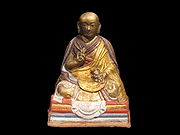

Mahayana
Mahāyāna is one of the two main existing branches of Buddhism and a term for classification of Buddhist philosophies and practice...
and the Vajrayana
Vajrayana
Vajrayāna Buddhism is also known as Tantric Buddhism, Tantrayāna, Mantrayāna, Secret Mantra, Esoteric Buddhism and the Diamond Vehicle...
schools of Buddhism with traditional Tibetan rituals of curing and exorcism
Exorcism
Exorcism is the religious practice of evicting demons or other spiritual entities from a person or place which they are believed to have possessed...
, shares the common Buddhist goal of individual release from suffering and the cycles of rebirth
Rebirth (Buddhism)
Rebirth in Buddhism is the doctrine that the evolving consciousness or stream of consciousness upon death , becomes one of the contributing causes for the arising of a new aggregation...
. The religion holds that salvation, in the sense of release from the cycle of rebirth, can be achieved through the intercession of compassionate Buddhas
Buddhahood
In Buddhism, buddhahood is the state of perfect enlightenment attained by a buddha .In Buddhism, the term buddha usually refers to one who has become enlightened...
(enlightened ones) who have delayed their own entry to the state of selfless bliss (nirvana) to save others. Such Buddhas, who also manifest as Bodhisattvas, are not treated a deities in a polytheistic sense, but rise as supramundane or enlightened beings in a universe of humans, mundane deities, opposing demons, converted and reformed demons, wandering ghosts, and that reflects the folk religion
Folk religion
Folk religion consists of ethnic or regional religious customs under the umbrella of an organized religion, but outside of official doctrine and practices...
s of the regions into which Buddhism expanded. Tantrism contributed esoteric techniques of meditation and a repertoire of sacred icons, phrases, and gestures
Mudra
A mudrā is a symbolic or ritual gesture in Hinduism and Buddhism. While some mudrās involve the entire body, most are performed with the hands and fingers...
that easily lent themselves to pragmatic (rather than transcendental) and magical interpretation. The religion posits progressive stages of enlightenment and comprehension of the reality underlying the illusions
Maya (illusion)
Maya , in Indian religions, has multiple meanings, usually quoted as "illusion", centered on the fact that we do not experience the environment itself but rather a projection of it, created by us. Maya is the principal deity that manifests, perpetuates and governs the illusion and dream of duality...
that hamper the understanding and perceptions of those not trained in meditation
Buddhist meditation
Buddhist meditation refers to the meditative practices associated with the religion and philosophy of Buddhism.Core meditation techniques have been preserved in ancient Buddhist texts and have proliferated and diversified through teacher-student transmissions. Buddhists pursue meditation as part of...
or Buddhist doctrine, with sacred symbols interpreted in increasingly abstract terms. Thus, a ritual that appears to a common yak herder as a straightforward exorcism of disease demons will be interpreted by a senior monk as a representation of conflicting tendencies in the mind of a meditating ascetic.
In Tibet Buddhism thus became an amalgam
Syncretism
Syncretism is the combining of different beliefs, often while melding practices of various schools of thought. The term means "combining", but see below for the origin of the word...
, combining colorful popular ceremonies and curing rituals for the masses with the rigerous academic studies of Buddhist canon in the monasteries. The Yellow Sect, in contrast to competing sects, stressed monastic discipline and the use of logic and formal debates as aids to enlightenment. The basic Buddhist tenet of reincarnation
Reincarnation
Reincarnation best describes the concept where the soul or spirit, after the death of the body, is believed to return to live in a new human body, or, in some traditions, either as a human being, animal or plant...
was combined with the Tantric idea that buddhahood could be achieved within a person's lifetime to produce a category of leaders who were considered to have achieved buddhahood and to be the reincarnations of previous leaders. These leaders, referred to as incarnate or living buddha
Tulku
In Tibetan Buddhism, a tulku is a particular high-ranking lama, of whom the Dalai Lama is one, who can choose the manner of his rebirth. Normally the lama would be reincarnated as a human, and of the same sex as his predecessor. In contrast to a tulku, all other sentient beings including other...
s, held secular power and supervised a body of ordinary monks, or lamas (from a Tibetan title bla-ma, meaning "the revered one)". The monks were supported by the laity, who thereby gained merit and who received from the monks instructions in the rudiments of the faith and monastic services in healing, divination, and funerals.Though Tibetan influence is prevalent in Mongolia, Mongolian Buddhism is unique and distinct with its own characteristics of Buddhism.
Early Introduction of Buddhism
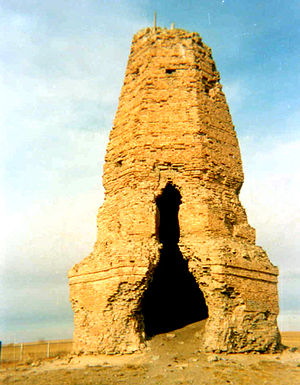
Sanskrit
Sanskrit , is a historical Indo-Aryan language and the primary liturgical language of Hinduism, Jainism and Buddhism.Buddhism: besides Pali, see Buddhist Hybrid Sanskrit Today, it is listed as one of the 22 scheduled languages of India and is an official language of the state of Uttarakhand...
origin,which are still used in Mongolia, were adopted via the Soghdian language.
The rulers of the pre-Mongol states such as Xiongnu
Xiongnu
The Xiongnu were ancient nomadic-based people that formed a state or confederation north of the agriculture-based empire of the Han Dynasty. Most of the information on the Xiongnu comes from Chinese sources...
, Xianbei
Xianbei
The Xianbei were a significant Mongolic nomadic people residing in Manchuria, Inner Mongolia and eastern Mongolia. The title “Khan” was first used among the Xianbei.-Origins:...
, Rouran
Rouran
Rouran , Mongolia name Jujan or Nirun Ruanruan/Ruru , Tan Tan , Juan-Juan or Zhu-Zhuwas the name of a confederation of nomadic tribes on the northern borders of Inner China from the late 4th century until the middle 6th century...
and Gokturk Empires received Buddhist priests and built temples for them. Buddhism prevailed among aristocrats and was patronised by the monarchs of the Northern Wei Dynasty established by Mongolic tribes of Xianbei
Xianbei
The Xianbei were a significant Mongolic nomadic people residing in Manchuria, Inner Mongolia and eastern Mongolia. The title “Khan” was first used among the Xianbei.-Origins:...
and of the Liao Dynasty
Liao Dynasty
The Liao Dynasty , also known as the Khitan Empire was an empire in East Asia that ruled over the regions of Manchuria, Mongolia, and parts of northern China proper between 9071125...
established by Mongolic tribes of Khitans. The Khitan aristocracy regarded Buddhism as culture of the Uighur Kaganate that dominated the Mongolian steppes before the rise of the Khitans. The monarchs of the Jin Dynasty
Jin Dynasty
Jin Dynasty may refer to:* Jin Dynasty , Chinese dynasty, subdivided into the Western and Eastern Jin periods* Later Jin Dynasty , one of the Five Dynasties during the Five Dynasties and Ten Kingdoms Period in China.* Jin Dynasty , a Jurchen kingdom in northern China* Later Jīn Dynasty, or...
established by nomadic tribes of Jurchens
Jurchens
The Jurchens were a Tungusic people who inhabited the region of Manchuria until the 17th century, when they adopted the name Manchu...
also regarded Buddhism as a Khitan heritage.
Later Introduction of Buddhism

Mongolian nobility
The Mongolian nobility arose in the 10-12th centuries, became prominent in the 13th century, and essentially governed Mongolia until the early 20th century....
s, until this practice was outlawed by the Qianlong Emperor
Qianlong Emperor
The Qianlong Emperor was the sixth emperor of the Manchu-led Qing Dynasty, and the fourth Qing emperor to rule over China proper. The fourth son of the Yongzheng Emperor, he reigned officially from 11 October 1735 to 8 February 1796...
.
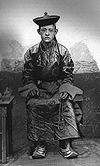
Ulaanbaatar
Ulan Bator or Ulaanbaatar is the capital and largest city of Mongolia. An independent municipality, the city is not part of any province, and its population as of 2008 is over one million....
was then known, was the seat of the preeminent living Buddha of Mongolia (the Jebtsundamba Khutuktu, also known as the Bogdo Gegen and later as Bogd Khan
Bogd Khan
The Bogd Khan was enthroned as the Great Khaan of Mongolia on 29 December 1911, when Outer Mongolia declared independence from the Qing Dynasty after the Xinhai Revolution. He was born in the Kham region of eastern Tibet, today's Sichuan province of the People's Republic of China...
), who ranked third in the ecclesiastical hierarchy, after the Dalai Lama and the Panchen Lama
Panchen Lama
The Panchen Lama , or Bainqên Erdê'ni , is the highest ranking Lama after the Dalai Lama in the Gelugpa lineage of Tibetan Buddhism...
. Two monasteries there contained approximately 13,000 and 7,000 monks, and the prerevolutionary Mongol name of the settlement known to outsiders as Urga, Ikh Huree, means "big monastery".
Over the centuries, the monasteries acquired riches and secular dependents, gradually increasing their wealth and power as the wealth and power of the Mongol nobility declined. Some nobles donated a portion of their dependent families — people, rather than land, were the foundation of wealth and power in old Mongolia — to the monasteries. Some herders dedicated themselves and their families to serve the monasteries, either from piety or from the desire to escape the arbitrary exactions of the nobility. In some areas, the monasteries and their living buddhas (of whom there were a total of 140 in 1924) were also the secular authorities. In the 1920s, there were about 110,000 monks, including children, who made up about one-third of the male population, although many of these lived outside the monasteries and did not observe their vows. About 250,000 people, more than a third of the total population, either lived in territories administered by monasteries and living Buddhas or were hereditary dependents of the monasteries. With the end of Manchu rule in 1911, the Buddhist church and its clergy provided the only political structure available. The autonomous state thus took the form of a weakly centralized theocracy, headed by the Jebtsundamba Khutukhtu in Yehe Kuriye.
By the twentieth century, Buddhism had penetrated deeply into Mongolian culture, and the populace willingly supported the lamas and the monasteries. Foreign observers usually had a negative opinion of Mongolian monks, condemning them as lazy, ignorant, corrupt, and debauched, but the Mongolian people did not concur. Ordinary Mongolians apparently combined a cynical and realistic anticlericalism, sensitive to the faults and the human fallibility of individual monks or groups of monks, with a deep and unwavering concern for the transcendent values of the church.
Situation of Buddhism in the MPR

Mongolian People's Revolutionary Party
The Mongolian People's Party formerly the Mongolian People's Revolutionary Party is an ex-communist political party in Mongolia. The party is abbreviated MPP in English and ' in Mongolian...
and its Soviet advisers for nearly twenty years. As late as 1934, the party counted 843 major Buddhist centers, about 3,000 temples of various sizes, and nearly 6,000 associated buildings, which usually were the only fixed structures in a world of yurt
Yurt
A yurt is a portable, bent wood-framed dwelling structure traditionally used by Turkic nomads in the steppes of Central Asia. The structure comprises a crown or compression wheel usually steam bent, supported by roof ribs which are bent down at the end where they meet the lattice wall...
s. The annual income of the church was 31 million Tögrögs, while that of the state was 37.5 million tögrögs. A party source claimed that, in 1935, monks constituted 48 percent of the adult male population. In a campaign marked by shifts of tactics, alternating between conciliation and persecution, and a fe reported uprisings led by monks and abbots, the Buddhist church was removed progressively from public administration, was subjected to confiscatory taxes, was forbidden to teach children, and was prohibited from recruiting new monks or replacing living Buddhas. The campaign's timing matched the phases of Joseph Stalin
Joseph Stalin
Joseph Vissarionovich Stalin was the Premier of the Soviet Union from 6 May 1941 to 5 March 1953. He was among the Bolshevik revolutionaries who brought about the October Revolution and had held the position of first General Secretary of the Communist Party of the Soviet Union's Central Committee...
's persecution of the Russian Orthodox Church
Russian Orthodox Church
The Russian Orthodox Church or, alternatively, the Moscow Patriarchate The ROC is often said to be the largest of the Eastern Orthodox churches in the world; including all the autocephalous churches under its umbrella, its adherents number over 150 million worldwide—about half of the 300 million...
. Robert Rupen reports that in the 1920s there were over 112,000 Mongolian Buddhist monks, representing more than 13% of Mongolia's overall population. By the 1940s, nearly every monk was either dead or had apostatized. In 1938 — amid accusations that the church and monasteries were trying to cooperate with the Japanese, who were promoting a pan-Mongol puppet state — the remaining monasteries were dissolved, their property was seized, and their monks were secularized, interned or executed. Those monastic buildings that had not been destroyed were taken over to serve as local government offices or schools. Only then was the ruling party, which since 1921 gradually had built a cadre of politically reliable and secularly educated administrators, able to destroy the church and to mobilize the country's wealth and population for its program of modernization and social change.
Since the late 1940s, one monastery, the Gandan Monastery, with a community of 100 monks, was open in Ulaanbaatar. It was the country's sole monastery and was more for international display than functionality. A few of the old monasteries survived as museums, and the Gandan Monastery served as a living museum and a tourist attraction. Its monks included a few young men who had undergone a five-year training period, but whose motives and mode of selection were unknown to Western observers. The party apparently thought that Buddhism no longer posed a challenge to its dominance and that — because Buddhism had played so large a part in the country's history
History of Mongolia
The area of what is now Mongolia has been ruled by various nomadic empires, including the Xiongnu, the Xianbei, the Nirun, the Gökturks, and others. The Mongol Empire was founded by Genghis Khan in 1206. After the collapse of the Yuan Dynasty in 1368, the Mongols returned to their earlier patterns...
, traditional arts and culture
Culture of Mongolia
Mongolian culture has been heavily influenced by the Mongol nomadic way of life. Other important influences are from Tibet and Tibetan Buddhism, and from China. Since the 20th century, Russian and, via Russia, European culture have had a strong effect on Mongolia...
, total extirpation of knowledge about the religion and its practices would cut modern Mongols off from much of their past, to the detriment of their national identity. A few aged former monks were employed to translate Tibetan-language handbooks on herbs and traditional medicine
Traditional Tibetan medicine
Traditional Tibetan medicine is a centuries-old traditional medical system that employs a complex approach to diagnosis, incorporating techniques such as pulse analysis and urinalysis, and utilizes behavior and dietary modification, medicines composed of natural materials and physical therapies...
. Government spokesmen described the monks of the Gandan Monastery as doing useful work. Today the monastery has been reinvigorated as the Gandantegchinlen Khiid Monastery
Gandantegchinlen Khiid Monastery
The Gandantegchinlen Monastery , is a Tibetan-style monastery in the Mongolian capital of Ulaanbaatar that has been restored and revitalized since 1990. The Tibetan name translates to the "Great Place of Complete Joy." It currently has over 150 monks in residence...
by the post-Communist governments of the country.
Buddhism, furthermore played a role in Mongolia's foreign policy by linking Mongolia with the communist and the noncommunist states of East and Southeast Asia. Ulaanbaatar was the headquarters of the Asian Buddhist Conference for Peace, which has held conferences for Buddhists from such countries as Japan, Vietnam
Buddhism in Vietnam
Buddhism in Vietnam as practiced by the ethnic Vietnamese is mainly of the Mahāyāna tradition. Buddhism came to Vietnam as early as the 2nd century CE through the North from Central Asia and via Southern routes from India...
, Cambodia
Buddhism in Cambodia
The kind of Buddhism practiced in Cambodia is called Theravada Buddhism. Buddhism has existed in Cambodia since at least the 5th century CE, with some sources placing its origin as early as the 3rd century BCE...
, Sri Lanka, and Bhutan
Buddhism in Bhutan
Mahayana Buddhism is the state religion of Bhutan, and Buddhists comprise two-thirds to three-quarters of its population. Although originating in Tibetan Buddhism, the Buddhism practiced in Bhutan differs significantly in its rituals, liturgy, and monastic organization...
; published a journal for international circulation; and maintained contacts with such groups as the Christian Peace Conference
Christian Peace Conference
The Christian Peace Conference was a Czech organization founded in 1958 by Josef Hromádka, a pastor who had spent the war years in the USA and moved back to Czechoslovakia when the war ended. Hromádka was a member of the Bureau of the World Peace Council...
, the Afro-Asian People's Solidarity Organization, and the Russian Orthodox Church. It sponsored the visits of the Dalai Lama to Mongolia in 1979 and 1982. The organization, headed by the abbot of then-Gandan Monastery, advanced the foreign policy goals of the Mongolian government
Foreign relations of Mongolia
Mongolia has diplomatic and foreign relations with many countries. It seeks a neutral and cordial relations with many countries including in cultural and economic matters.-Egypt:...
, which were in accord with those of the Soviet Union
Foreign relations of the Soviet Union
At its founding, the Soviet Union was considered a pariah by most governments because of its communism, and as such was denied diplomatic recognition by most states...
.
List of Khutukhtus of Khalkha
- Bogda Jebtsundamba Khutukhtu (Богд Жавзандамба хутагт)
- Bambar Erdeni Hubilgan (Бамбар Эрдэнэ хувилгаан)
- Blama-yin Gegegen (Ламын гэгээн)
- Ching Sujigtu Nomun Khan Khutukhtu (Чин Сүжигт Номун Хан хутагт)
- Dilova Khutukhtu (Дилав хутагт)
- Doghshin Noyan Khutukhtu (Догшин ноён хутагт)
- Heuhen Khutukhtu (Хүүхэн хутагт)
- Ilghaghsan Khutukhtu (Ялгасан хутагт)
- Ilaghughsan Khutukhtu (Ялгуусан хутагт)
- Jalkhantsa KhutukhtuJalkhanz Khutagt Sodnomyn DamdinbazarThe Jalkhanz Khutagt Sodnomyn Damdinbazar was a high lamaist incarnation in northwestern Mongolia, and played a high-profile role in the country's independence movement...
(Жалханз хутагт) - Khamba Nomun Khan Khutukhtu (Хамба Номун Хан хутагт)
- Mantsusri Khutukhtu (Манзушри хутагт)
- Naro Panchen Khutukhtu (Нар Ванчин хутагт)
- Shavron Khutukhtu (Шаврон хутагт) the last reincarnation Gombosuren born in 1925 is living
- Yogachara Khutukhtu (Егүзэр хутагт)
- Zaya Pandita Khutukhtu (Зая Бандида хутагт)
- Kanjurwa Khutukhtu (Ганжуурва хутагт)
- Jasrai Gegegen (Жасрай гэгээн)
- VajradharaVajradharaVajradhara is the ultimate primordial Buddha, or Adi Buddha, according to the Gelug and Kagyu schools of Tibetan Buddhism.In the evolution of Indian Buddhism, Vajradhara gradually displaced Samantabhadra, who remains the...
Hubilgan (Очирдар хувилгаан) - Bari Yonjan Damtsag Dorje (Бари Ёнзин Дамцагдорж)
External links
- Documentation on Mongolian monasteries and temples (mainly in Mongolian)

